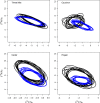Isotopic niche size of Coregonus artedi (sensu lato) Increases in the presence of Mysis diluviana, expanded habitat use and phenotypic diversity
- PMID: 33144995
- PMCID: PMC7593162
- DOI: 10.1002/ece3.6807
Isotopic niche size of Coregonus artedi (sensu lato) Increases in the presence of Mysis diluviana, expanded habitat use and phenotypic diversity
Abstract
Post-glacial colonization of lakes in Algonquin Park, Ontario, Canada resulted in food webs with cisco (Coregonus artedi sensu lato) and either Mysis diluviana or Chaoborus spp. as the dominant diel migrator. Mysis as prey, its diel movements and benthic occupancy, are hypothesized to be key elements of ecological opportunity for cisco diversity in the Laurentian Great Lakes. If correct, the hypothesis strongly implies that lakes with Mysis would have greater trophic niche size and drive greater adaptive radiation of cisco forms relative to lakes without Mysis. The dichotomy in diel migrator in Algonquin Park lakes was an opportunity to assess the isotopic niche size of cisco (δ15N and δ13C) and determine if niche size expands with Mysis presence. We found the presence of Mysis is necessary to expand isotopic niche size in our study lakes. The use of habitats not typically associated with the ancestral form of cisco (e.g., benthic habitats) and phenotypic diversity (blackfin and cisco) also continue to expand niche size in Mysis-based food webs. Partial ecological speciation based on a large niche space appears to be present in one lake (Cauchon Lake) where use of alternative habitats is the only real difference in cisco. The presence of blackfin expands niche space in Cedar and Radiant Lakes. This was not matched in Hogan Lake where niche space was relatively smaller with similar forms. Possible reasons for this discrepancy may be related to the asymmetric basin of Hogan Lake and whether the two forms overlap during cool and cold-water periods of the annual temperature cycle. By comparing trophic niche size among lakes with and without Mysis, we conclude that Mysis provides a key ecological opportunity for cisco diversity in our study lakes and likely more widely.
Keywords: cisco diversity; ecological speciation; isotopes.
© 2020 The Authors. Ecology and Evolution published by John Wiley & Sons Ltd.
Conflict of interest statement
None declared.
Figures





References
-
- Ahrenstorff, T. D. , Hrabik, T. R. , Stockwell, J. D. , Yule, D. L. , & Sass, G. G. (2011). Seasonally dynamic diel vertical migrations of Mysis diluviana, coregonine fishes, and siscowet lake trout in the pelagia of western Lake Superior. Transactions of the American Fisheries Society, 140, 1504–1520.
-
- Almond, J. , Bentzen, E. , & Taylor, W. D. (1996). Size structure and species composition of plankton communities in deep Ontario lakes with and without Mysis relicta and planktivorous fish. Canadian Journal of Fisheries and Aquatic Sciences, 53, 315–325.
-
- Barth, L. E. , Sprules, W. G. , Wells, M. , & Coman, M. (2014). Seasonal changes in the diel vertical migration of Chaoborus punctipennis larval instars. Canadian Journal of Fisheries and Aquatic Sciences, 71, 665–674.
Associated data
LinkOut - more resources
Full Text Sources
Miscellaneous

